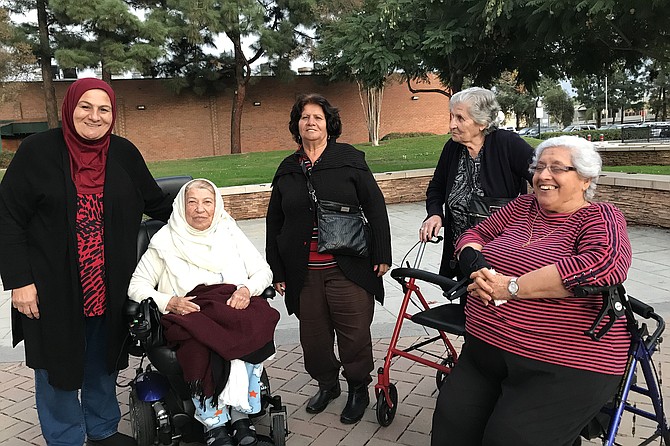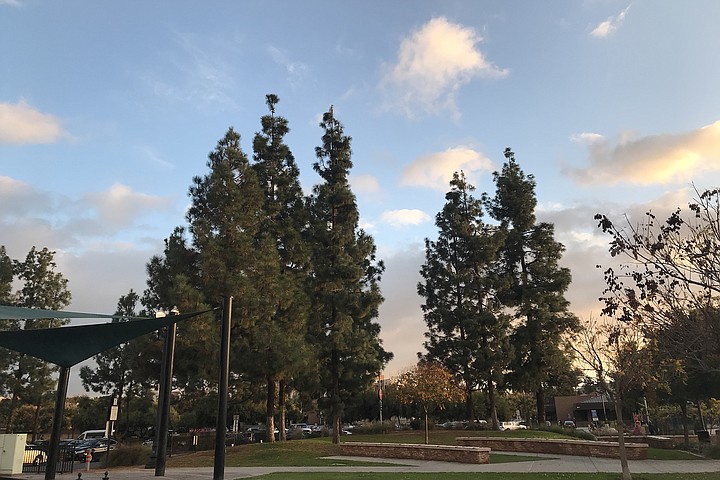 Facebook
Facebook
 X
X
 Instagram
Instagram
 TikTok
TikTok
 Youtube
Youtube

It is 4:30 on a Thursday afternoon. Sun’s rays climb slowly up the beautiful urban forest of downtown El Cajon’s 30-foot pine trees. I meander down East Main, really because I like to see the Chaldean and other Middle Eastern men gathering to play dominos and card games in the courtyard of the Park Cafe where the Prestcott Promenade links Main and Douglas.
But what grabs me tonight is not the conversation and laughter of old men. It’s an incredible rush of wings, luminous green in the horizontal sunlight, and, more remarkable, what sounds like a kids’ playground in the sky. Not screams and squawks, but a thousand birds chatting, gurgling, flirting, having one last play together before closing down for the night.
“Babagha,” says Hemmat. “Parrots. They gather, we gather. Every night at sunset. Also to talk.”
With all the men gathered at The Park’s tables, I hadn’t noticed separate groups of women across the park.
Hemmat is a Chaldean lady.
What strikes me is this rarity — of the richness of nature, right here in town. With today’s bird life so minimized — anybody remember Rachel Carson’s Silent Spring? — that just to hear a sparrow chirp makes you prick up your ears. This incredible noisy invasion of maybe 800 parrots into San Diego (according to some estimates), who, you read, have the intelligence of 3-year-old children, almost feels like a return to some Garden of Eden.

Yes, invasions of non-native species like these mitred red, blue-crowned and red-masked parakeets, plus red-crowned and lilac-crowned amazons, look and sound massive here. You think Alfred Hitchcock, The Birds. These parrots have been spotted here and at the courthouse, in PB, OB, Oceanside, Escondido, Point Loma, and elsewhere. And yet nobody here feels threatened. “We like them,” says a Chaldean gent named Robert.
It’s just the noise, and worries about species that they may be crowding out, that concern some. But USD’s biologist Dr. Janel Ortiz, who started the SD Parrot Project, isn’t worried for native birds and animals. “The parrots here are confined to urban environments and depend on palms and eucalyptus for food and shelter. They are not native resources,” she recently told the U-T.
Still, for downtowners, the squawking must feel like having a football crowd fly in every night at 4:30, at least at this time of year. One thing you know: ain’t no wall going to stop these guys.
“I am 83,” says Almas (her name means “Diamond”). “I have been coming here for 20 years. We are three social clubs who gather here every evening. The men over there, the women here, and now the babagha up in the pine trees.”
Now two surprising things happen: the entire parrot colony ups and heads off across East Main to the pine trees at the City Courthouse. You can hear all the squawking and joshing at a distance. Then when darkness falls, suddenly everything ceases. Total silence. You can hear cars again. You can hear music coming from Testo Pepesto Italian restaurant.
For us humans, the night is just beginning. But for the parrots of El Cajon, Happy Hour is over. But you know they’ll be back.
Call it evolution.


It is 4:30 on a Thursday afternoon. Sun’s rays climb slowly up the beautiful urban forest of downtown El Cajon’s 30-foot pine trees. I meander down East Main, really because I like to see the Chaldean and other Middle Eastern men gathering to play dominos and card games in the courtyard of the Park Cafe where the Prestcott Promenade links Main and Douglas.
But what grabs me tonight is not the conversation and laughter of old men. It’s an incredible rush of wings, luminous green in the horizontal sunlight, and, more remarkable, what sounds like a kids’ playground in the sky. Not screams and squawks, but a thousand birds chatting, gurgling, flirting, having one last play together before closing down for the night.
“Babagha,” says Hemmat. “Parrots. They gather, we gather. Every night at sunset. Also to talk.”
With all the men gathered at The Park’s tables, I hadn’t noticed separate groups of women across the park.
Hemmat is a Chaldean lady.
What strikes me is this rarity — of the richness of nature, right here in town. With today’s bird life so minimized — anybody remember Rachel Carson’s Silent Spring? — that just to hear a sparrow chirp makes you prick up your ears. This incredible noisy invasion of maybe 800 parrots into San Diego (according to some estimates), who, you read, have the intelligence of 3-year-old children, almost feels like a return to some Garden of Eden.

Yes, invasions of non-native species like these mitred red, blue-crowned and red-masked parakeets, plus red-crowned and lilac-crowned amazons, look and sound massive here. You think Alfred Hitchcock, The Birds. These parrots have been spotted here and at the courthouse, in PB, OB, Oceanside, Escondido, Point Loma, and elsewhere. And yet nobody here feels threatened. “We like them,” says a Chaldean gent named Robert.
It’s just the noise, and worries about species that they may be crowding out, that concern some. But USD’s biologist Dr. Janel Ortiz, who started the SD Parrot Project, isn’t worried for native birds and animals. “The parrots here are confined to urban environments and depend on palms and eucalyptus for food and shelter. They are not native resources,” she recently told the U-T.
Still, for downtowners, the squawking must feel like having a football crowd fly in every night at 4:30, at least at this time of year. One thing you know: ain’t no wall going to stop these guys.
“I am 83,” says Almas (her name means “Diamond”). “I have been coming here for 20 years. We are three social clubs who gather here every evening. The men over there, the women here, and now the babagha up in the pine trees.”
Now two surprising things happen: the entire parrot colony ups and heads off across East Main to the pine trees at the City Courthouse. You can hear all the squawking and joshing at a distance. Then when darkness falls, suddenly everything ceases. Total silence. You can hear cars again. You can hear music coming from Testo Pepesto Italian restaurant.
For us humans, the night is just beginning. But for the parrots of El Cajon, Happy Hour is over. But you know they’ll be back.
Call it evolution.
Comments